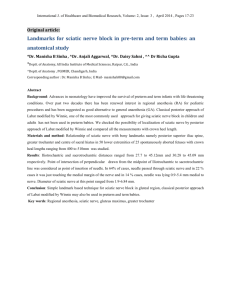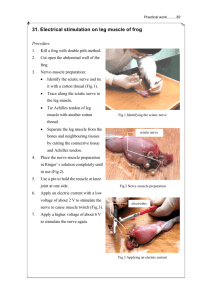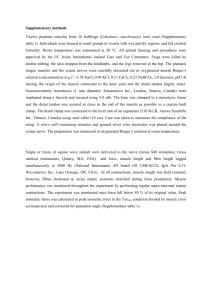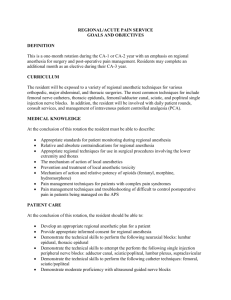Posterior Side of Thigh
advertisement
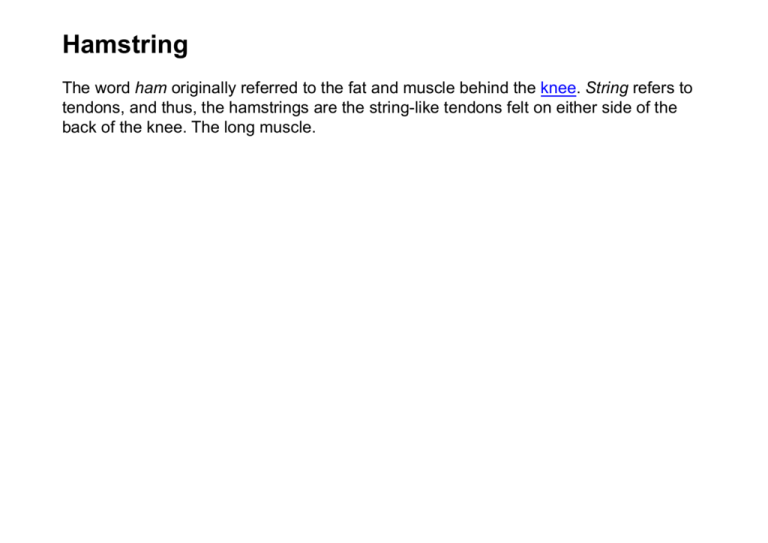
Hamstring The word ham originally referred to the fat and muscle behind the knee. String refers to tendons, and thus, the hamstrings are the string-like tendons felt on either side of the back of the knee. The long muscle. THE ADDUCTOR MAGNUS AND ADDUCTOR MINIMUS MUSCLES Adductor magnus Adductor part: inferior ramus of pubis, ramus of ischium Hamstrings part: ischial tuberosity Adductor part: gluteal tuberosity, linea aspera, medial supracondylar line Hamstrings part: adductor tubercle of femur Adductor part: obturator nerve (L2, L3, L4), branches of posterior division Hamstrings part: tibial part of sciatic nerve (L4) Adducts thigh Adductor part: flexes thigh Hamstrings part: extends thigh Muscle Attachment Distal Attachment Innervation Main Action Adductor magnus Adductor part: inferior ramus of pubis, ramus of ischium Hamstrings part: ischial tuberosity Adductor part: gluteal tuberosity, linea aspera, medial supracondylar line Hamstrings part: adductor tubercle of femur Adductor part: obturator nerve (L2, L3, L4), branches of posterior division Hamstrings part: tibial part of sciatic nerve (L4) Adducts thigh Adductor part: flexes thigh Hamstrings part: extends thigh Semi tendinosus Ishchial tuberosity Medial surface of superior part of tibia Tibial division of sciatic nerve part of tibia (L5, S1, S2) Extend thigh; flex leg and rotate it medially when knee is flexed; Semi membranosus Biceps femoris when thigh and leg are flexed, these muscles can extend trunk Posterior part of medial condyle of tibia; reflected attachment forms oblique popliteal ligament (to lateral femoral condyle) Long head: ischial tuberosity Short head: linea aspera and lateral supracondylar line of femur Lateral side of head of fibula; tendon is split at this site by fibular collateral ligament of knee Long head: tibial division of sciatic nerve (L5, S1, S2) Short head: common fibular division of sciatic nerve (L5, S1, S2) Flexes leg and rotates it laterally when knee is flexed; extends thigh (e.g., when starting to walk) THE BICEPS FEMORIS MUSCLE Long head: ischial tuberosity Short head: linea aspera and lateral supracondylar line of femur Lateral side of head of fibula; tendon is split at this site by fibular collateral ligament of knee Long head: tibial division of sciatic nerve (L5, S1, S2) Short head: common fibular division of sciatic nerve (L5, S1, S2) Flexes leg and rotates it laterally when knee is flexed; extends thigh (e.g., when starting to walk) THE SEMITENDINOSUS MUSCLE Ishchial tuberosity Medial surface of superior part of tibia Tibial division of sciatic nerve part of tibia (L5, S1, S2) Extend thigh; flex leg and rotate it medially when knee is flexed; when thigh and leg are flexed, these muscles can extend trunk THE SEMIMEMBRANOSUS MUSCLE Ishchial tuberosity Posterior part of medial condyle of tibia; reflected attachment forms oblique popliteal ligament (to lateral femoral condyle) Tibial division of sciatic nerve part of tibia (L5, S1, S2) Extend thigh; flex leg and rotate it medially when knee is flexed; when thigh and leg are flexed, these muscles can extend trunk THE POPLITEUS MUSCLE The popliteus muscle causes medial rotation of either the femur or the tibia. It also unlocks the knee joint when the leg is fully extended and beginning to bend and furthermore aids in keeping the femur from pushing forward when you crouch. This muscle arises as a tendon from the lateral condyle and the capsule of the knee joint of the femur. It descends across the joint medially and broadens as a short, flat, triangular muscle to insert on the medial side of the tibia just below the medial condyle and above the soleal line. • • • Popliteus comes from the Latin poples, meaning ham. THE GASTROCNEMIUS MUSCLE The gastrocnemius muscle is a less powerful plantarflexor than the soleus muscle. It also a knee flexor, helping to bend the knee, and provide propuslion when you walk, run, and jump. It has two parts. The medial head arises as a tendon on the medial condyle of the femur, and the lateral head arises on the lateral condyle of the femur. The muscle forms two bellies that lie side by side and end mid‐calf in an aponeurosis which gradually merges to become the Achilles tendon at the place where it merges with the tendon of the soleus. • • • Gastrocnemius is Latin from the Greek words gaster meaning stomach or belly, and kneme meaning that part of the leg between knee and ankle. Injuries Straining of the hamstring, also known as a pulled hamstring, is defined as an excessive stretch or tear of muscle fibers and related tissues. Use in surgery The distal semitendinosis tendon is one of the tendons that can be used in the surgical procedure ACL reconstruction. In this procedure, a piece of it is used to replace the anterior cruciate ligament (ACL). The ACL is one of the four major ligaments in the knee. Sciatic nerve The sciatic nerve (also known as the ischiatic nerve) is a large nerve that starts in the lower back and runs through the buttock and down the lower limb. It is the longest and largest single nerve in the body. The sciatic supplies nearly the whole of the skin of the leg, the muscles of the back of the thigh, and those of the leg and foot. Anatomical course The nerve enters the lower limb by exiting the pelvis through the greater sciatic foramen, below the Piriformis muscle. It descends midway in the greater trochanter of the femur and the tuberosity of the ischium, and along the back of the thigh to about its lower third, where it divides into two large branches, the tibial and common peroneal nerves. This division may take place at any point between the sacral plexus and the lower third of the thigh. When it occurs at the plexus, the common peroneal nerve usually pierces the Piriformis muscles. In the upper part of its course, the nerve rests upon the posterior surface of the ischium, the nerve to the Quadratus femoris, the Obturator internus and Gemelli; it is accompanied by the posterior femoral cutaneous nerve and the inferior gluteal artery, and is covered by the Gluteus maximus. Lower down, it lies upon the Adductor magnus, and is crossed obliquely by the long head of the Biceps femoris. Branches The nerve gives off articular and muscular branches. The articular branches (rami articulares) arise from the upper part of the nerve and supply the hip-joint, perforating the posterior part of its capsule; they are sometimes derived from the sacral plexus. The muscular branches (rami musculares) are distributed to the following muscles of the lower limb: Biceps femoris, Semitendinosus, Semimembranosus, and Adductor magnus. The nerve to the short head of the Biceps femoris comes from the common peroneal part of the sciatic, while the other muscular branches arise from the tibial portion, as may be seen in those cases where there is a high division of the sciatic nerve. The muscular branch eventually gives off the tibial nerve and common peroneal nerve, which innervates the muscles of the (lower) leg. The tibial nerve goes on to innervate all muscles of the foot except the extensor digitorum brevis (peroneal nerve). Pathology Pain caused by a compression or irritation of the sciatic nerve by a problem in the lower back is called sciatica. Common causes of sciatica include the following low back conditions: spinal disc herniation, degenerative disc disease, spinal stenosis, and spondylolisthesis. Relationship of sciatic nerve to piriformis. A. The sciatic nerve usually emerges from the greater sciatic foramen inferior to the piriformis. B. In 12.2% of 640 limbs studied, the sciatic nerve divided before exiting the greater sciatic foramen, the common fibular division (yellow) passed through the piriformis. C. In 0.5% of cases, the common fibular division passed superior to the muscle, where it is especially vulnerable to injury during intragluteal injections. The popliteal fossa houses: 1. popliteal artery, which is a continuation of the femoral artery 2. popliteal vein 3. tibial nerve 4. common peroneal nerve 5. Six or seven popliteal lymph nodes are embedded in the fat 6. The roof contains a portion of the small saphenous vein and posterior cutaneous nerve of the thigh. Boundaries The boundaries of the fossa are: superior and medial: the semitendinosus muscle (semimembranosus is medial to the semitendinosus.) superior and lateral: the biceps femoris muscle inferior and medial: the medial head of the gastrocnemius muscle inferior and lateral: the lateral head of the gastrocnemius muscle

